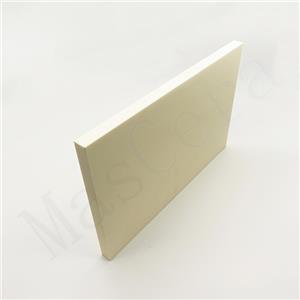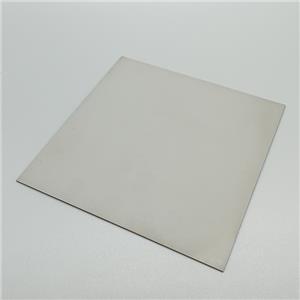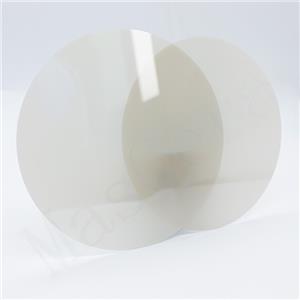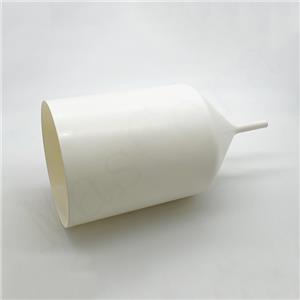Application of advanced Ceramics in New Energy Vehicles
In the new energy vehicle industry, the application of various advanced materials is the foundation that supports the entire industry. In this article, we will explore the increasingly important role of ceramics in the intelligentization process of new energy vehicles.
In the core motor drive of new energy vehicles, the use of SiC MOSFET devices provides a 5% to 10% increase in range compared to traditional Si IGBT, and it is expected to gradually replace Si IGBT in the future. However, SiC MOSFET chips have a small area and high heat dissipation requirements. Ceramic copper-clad laminate is a composite material with a copper-ceramic-copper "sandwich" structure. It has the characteristics of good heat dissipation, high insulation, high mechanical strength, thermal expansion matching with chips, and also has the characteristics of strong current carrying capacity, good welding and bonding performance, and high thermal conductivity of oxygen-free copper. It has almost become a necessary choice for SiC MOSFETs in the field of new energy vehicles. Silicon nitride ceramic substrates have excellent heat dissipation ability and high reliability, making them one of the key packaging materials for SiC MOSFET modules.
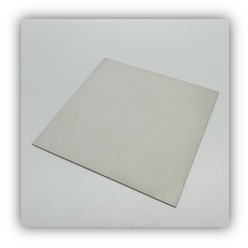
Ceramic Relays
Electronic control technology is an important indicator of the development level of new energy-saving electric vehicles, and high-voltage DC ceramic relays are the core components of electronic control systems. In a high-voltage DC vacuum relay, the ceramic insulator slides between the moving contact assembly and the driving rod in a vacuum chamber sealed by metal and ceramics, ensuring good electrical insulation between the moving and stationary contacts in any state of conduction or disconnection, maintaining a magnetic circuit system with the relay's magnetic yoke plates and iron cores, etc., and ensuring the relay's arc extinguishing ability when switching high-voltage DC loads. Arcing is a major cause of vehicle combustion. Only relay products that achieve "arc-free" connection and disconnection can fundamentally solve the problem of "combustion."
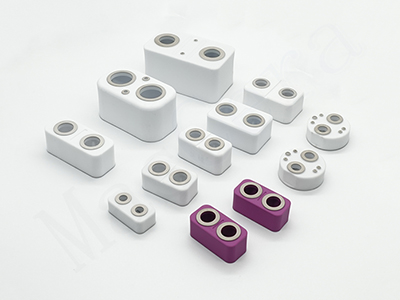
Relay Ceramic Housing
Ceramic Fuses
Fuses are devices used to protect circuits from overcurrent. When in operation, the fuse is connected in series in the circuit, and the load current flows through the fuse. When a short circuit or overload occurs in the circuit, the thermal effect of overcurrent melts and vaporizes the fuse element, creating a gap that produces an arc. The fuse cuts off the faulty circuit by extinguishing the arc, thereby protecting the circuit.
Automotive fuses are divided into low-voltage and high-voltage parts, with high-voltage protection mainly applicable to new energy vehicles. The applied voltage is generally 60VDC-1500VDC, mainly for protecting the main and auxiliary circuits of power fuses (high-voltage fuses for new energy vehicles). As the new energy vehicle market enters the post-subsidy era and personal consumption demand drives the high-voltage platform of new energy vehicles, the requirements for safety in high-voltage areas such as fast charging, motors, power devices, etc., cannot be ignored. The stability and fast interrupting ability of fuses will continue to experience high-speed growth in the rapid growth of new energy vehicles.
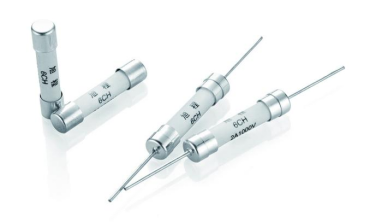
Ceramic Fuses
Multilayer Ceramic Capacitors (MLCC)
Multilayer ceramic capacitors (MLCCs) are known as the "rice" of the electronics industry and are one of the most widely used passive electronic components globally. Almost all consumer electronics require the use of MLCC components. Compared to traditional vehicles, the level of electrification in electric vehicles has greatly increased. From the newly added electronic control and battery management systems to audio and entertainment systems, ADAS systems, and fully autonomous driving systems, the increased level of vehicle electrification has greatly promoted the growth of automotive MLCCs.
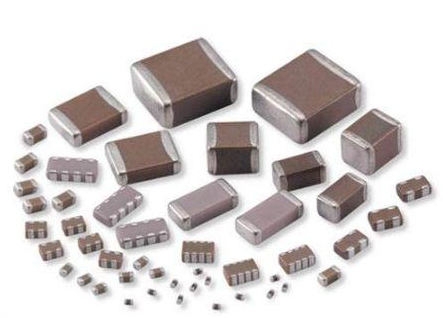
Multilayer Ceramic Capacitors
The application of ceramic bearings in new energy vehicles has become a trend. New energy vehicles have placed more demands on automotive bearings. Firstly, compared to traditional bearings, motor bearings have higher rotational speeds and require materials with lower density and better wear resistance. Secondly, due to the changing electromagnetic field caused by alternating currents in the motor, better insulation is needed to reduce bearing corrosion caused by electric discharge. Thirdly, the bearing ball surface needs to be smoother with less wear. Ceramic balls have characteristics such as low density, high hardness, and excellent wear resistance, making them suitable for high-speed rotation in high-temperature, strong magnetic, and high vacuum environments. They are irreplaceable in these fields.
Tesla's motors use ceramic bearings for their output shafts, specifically hybrid ceramic bearings designed by NSK, with 50 silicon nitride balls. Audi's ATA250 motor also uses ceramic bearings for its two internal rotor bearings.
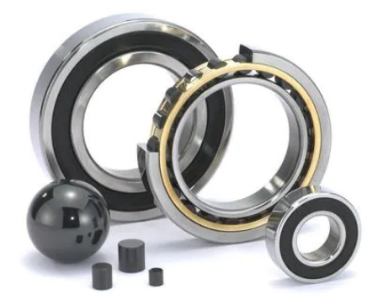
Ceramic Bearings
Carbon-ceramic (C/C-SiC) composite material is a new type of brake pad material developed based on carbon/carbon composite materials. It uses a three-dimensional carbon fiber needle-punched felt as the reinforced skeleton and is composite by depositing carbon, SiC, and residual silicon. This material combines the physical properties of carbon fiber and polycrystalline silicon carbide and exhibits characteristics such as high temperature stability, high thermal conductivity, and high specific heat. Additionally, carbon ceramic brakes have the advantages of lightweight and wear resistance. They not only extend the service life of brake discs but also avoid all problems caused by load. According to research, a pair of carbon ceramic brake discs can reduce the weight of the vehicle suspension system by 20 kg compared to cast iron brake discs of the same size, which can increase the range of electric vehicles by approximately 50 km. In the context of the electrification, intelligentization, and high-end development trends in the new energy vehicle industry, carbon ceramic brake systems can significantly improve vehicle response speed, shorten braking distance, and are expected to become the best actuators for line control braking. They can be considered as key lightweight components for future electric vehicles.

Ceramic Brake Discs
Ceramic Battery Sealing Connectors
Ceramic battery sealing connectors are an important component of new energy electric vehicles. They are used to form sealed and conductive connections between the battery cover plate and the electrode column in new energy electric vehicles.
Ceramics have superior electrical insulation and mechanical strength, making them increasingly common in the electronics industry as sealing components. In recent years, leading battery companies have gradually replaced common plastic seals with ceramic seals, significantly improving safety.
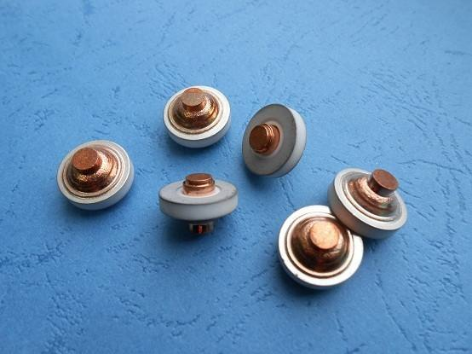
Battery Sealing Connectors
Ceramic Battery Separators
Polyolefin membranes are currently the mainstream membranes, but their thermal stability is relatively poor. The melting points of polypropylene (PP) and polyethylene (PE) are 165°C and 135°C, respectively, which can cause potential safety issues because the membrane shrinks or melts at high temperatures, leading to internal short circuits, fires, or even explosions. In response to this situation, various methods have been adopted to improve the thermal stability of membranes, and coating a layer of inorganic ceramic particles on PP or PE membranes is considered the most effective and economical method. Ceramic materials provide high heat resistance, while adhesives provide adhesion to maintain the structural integrity of the coating and the entire composite membrane. On one hand, this ceramic-coated membrane effectively improves the safety of lithium-ion batteries by preventing short circuits at high temperatures due to the improved thermal stability. On the other hand, the ceramic-coated membrane has good wetting and liquid retention capabilities with electrolytes and positive/negative electrode materials, greatly enhancing the battery's performance and lifespan. Commonly used ceramic materials include alpha-alumina, boehmite, SiO2, CeO2, MgAl2O4, ZrO, and TiO2.
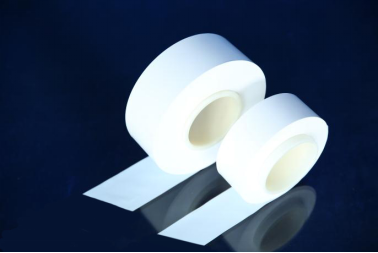
Ceramic coating layer
XIAMEN MASCERA TECHNOLOGY CO., LTD. is a reputable and reliable supplier specializing in manufacturing and sales of technical ceramic parts. We provide custom production and high precision machining for a wide series of high performance ceramic materials including alumina ceramic, zirconia ceramic, silicon nitride, silicon carbide, boron nitride, aluminum nitride and machinable glass ceramic. Currently, our ceramic parts can be found in many industries like mechanical, chemical, medical, semiconductor, vehicle, electronic, metallurgy etc. Our mission is to provide the best quality ceramic parts for global users and it is a big pleasure to see our ceramic parts work efficiently in customers' specific applications. We can cooperate on both prototype and mass production, welcome to contact us if you have demands.

